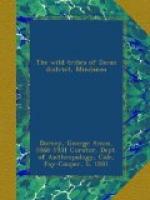[2] When the deceased has been a person of note the coffin is sometimes decorated or colored. The coffin of a magani should be red, yellow, and black; while that of a mabalian should be yellow, black, and brown.
Following the burial the family lives in the house where the death occurred until a human sacrifice has been made. During this period they live very quietly, eat poor food, wear old clothing, and abstain from all amusements. If their wealth permits, they may shorten the period of mourning by making a special sacrifice, but in most cases the bereaved will wait until the yearly sacrifice when they will purchase a share in the victim and thus remove the taboo. Following the offering, the old house is abandoned and is allowed to fall to pieces for “the man has gone and his house must go also.” The procedure is the same for women, and for children who have survived infancy.
BELIEFS CONCERNING THE SOUL, SPIRITS, ORACLES, AND MAGIC.
There is some variance, in different parts of the Bagobo area, in the beliefs concerning the spirits or souls of a man. In Cibolan each man and woman is supposed to have eight spirits or gimokod, which dwell in the head, the right and left hands and feet, and other parts not specified. At death these gimokod part, four from the right side of the body, going up to a place called palakalangit, and four descending to a region known as karonaronawan.These places differ in no respects from the present home of the Bagobo, except that in the region above it is always day, and all useful plants grow in abundance. In these places the gimokod are met by the spirits, Toglai and Tigyama, and by them are assigned to their future homes. If a man has been a datu on earth, his spirits have like rank in the other life, but go to the same place as those of common people. The gimokod of evil men are punished by being crowded into poor houses. These spirits may return to their old home for short periods, and talk with the gimokod of the living through dreams, but they never return to dwell again on earth.




